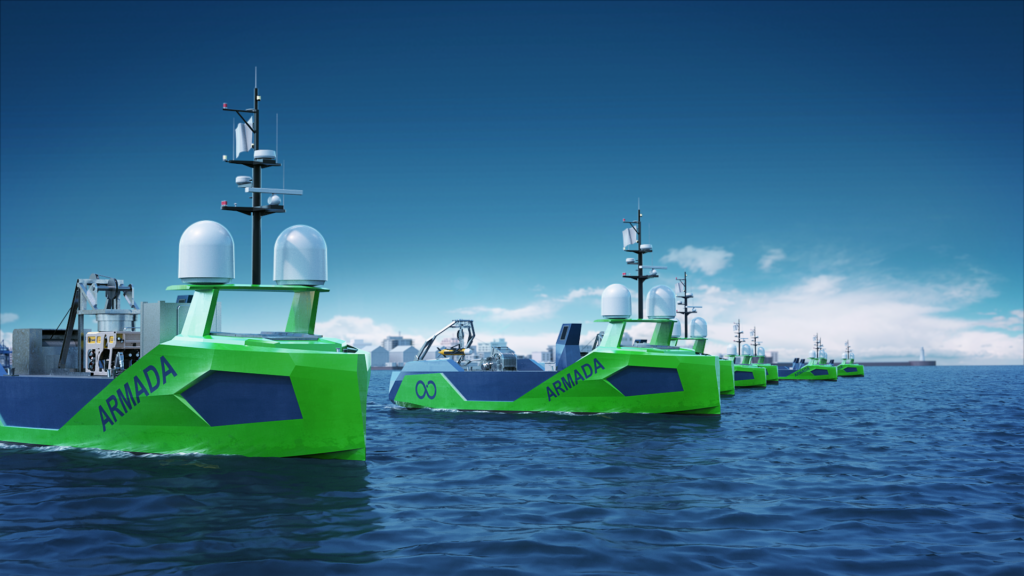
Ocean Infinity chose Iris Recognition Technology for contactless Iris-based Biometric authentication
Robotic Vessels Roam the Seas
On any day, Ocean Infinity’s fleet of marine robotic equipment including autonomous underwater vehicles (AUVs) are searching the world’s seas to acquire and analyze data on behalf of governments, energy companies, and scientific organizations. The company is a pioneer in the use of marine robotic vessels equipped with high-tech sensors.
Ocean Infinity announced in 2020 that it was creating a fleet of robotic ships named Armada. The uncrewed Armada fleet will see Ocean Infinity own and operate the most high-tech, green, and safe maritime fleet in the world by the time it launches at the end of 2021.
With Armada potentially scattered between the North Sea, the Mediterranean, and the Gulf of Mexico, 20 operators will remotely control every move of the 17 robotic ships and more AUVs from a highly secured Southampton, United Kingdom, facility. The vessels will provide services such as search and salvage, offshore construction support, or scientific data collection. While conducting their missions, these robotic vessels generate only one-tenth of the harmful carbon dioxide emissions created by similar-size crewed vessels.
Ocean Infinity’s vessels, ranging from 21 to 78 meters in length, will launch from bays, shorelines, or large ships. The largest vessels will be able to stay at sea for up to six weeks before returning to port. The pickup truck size AUVs can be shipped or flown to where they are needed.
“Without a need to worry about a crew, the missions just keep going ,” says Dan Hook, chief technology officer at Ocean Infinity. “That’s one of the big advantages of robotics. Also, human crews get tired and make mistakes that create accidents and
injuries. We can eliminate that with our robotic vessels.”The Southampton facility, which opened in August 2021, houses the Remote Control Centre, a data center, and other administrative and engineering offices. The remote-control operators work with computers and highly specialized software to track and navigate the ships and AUVs.
“We’ve avoided linking each of the remote-control stations to a specific robot,” Hook says. “Things like joysticks, buttons, and dials are all quite robot-specific. If we do everything using software, we can easily deploy different stations to different robots.”
A combination of satellite and terrestrial radio signals and LTE communications will enable vessel control. Ship-collected data will be sent in real-time to Southampton via satellite communications or downloaded when the vessels visit a port. The data collected for customers, will be protected by security plans safeguarding the information, much of which could have commercial, governmental, or political sensitivities.
Critical Access Control System
“We decided from day one we wanted total control over people going in and out of critical areas in our facility—not just for visitors, but for our entire staff,” Hook says. “We need to keep the people remotely navigating our vessels focused. We can’t afford to have them distracted by random visitors—just like it’s not appropriate to wander onto the bridge of a crewed ship or into an airliner cockpit.”
Ocean Infinity is following standards set by the International Ship and Port Facility Security Code, Hook says, which prescribes minimum security arrangements for governments, shipping companies, shipboard personnel, and port operators to detect and deter threats to international maritime trade.

Paul Stanborough, managing director of Aditech Ltd., a UK-based distributor of iris recognition and identification solutions, says during his early meetings with Ocean Infinity officials, they made it clear they wanted a strong security solution built into their new project.
A perimeter fence surrounds the entire Southampton site, with security guards on duty 24/7. Surveillance cameras placed throughout the area use analytics to spot anomalies, and an intruder alarm system detects unauthorized people attempting to enter the facility.
An access control system using smartcard credentials uses readers mounted on 35 doors, including building entrances and interior offices. The fleet operators enroll for iris-based biometric authentication, which works in tandem with the access control system. Iris readers are located at 10 doors considered mission-critical, including the control and communications rooms, the manager’s office, and engineer’s areas, to provide high-level, two-factor identity authentication.
The project’s security integrator, Andy Scowen, director of the UK-based Network Security and Alarms, says Ocean Infinity initially considered using fingerprint, iris, or facial biometric readers.
“Fingerprint technology was dropped due to COVID-19 concerns,” he adds. “Ocean Infinity chose the iris technology because it is contactless and was seen by the team as the most accurate.”

